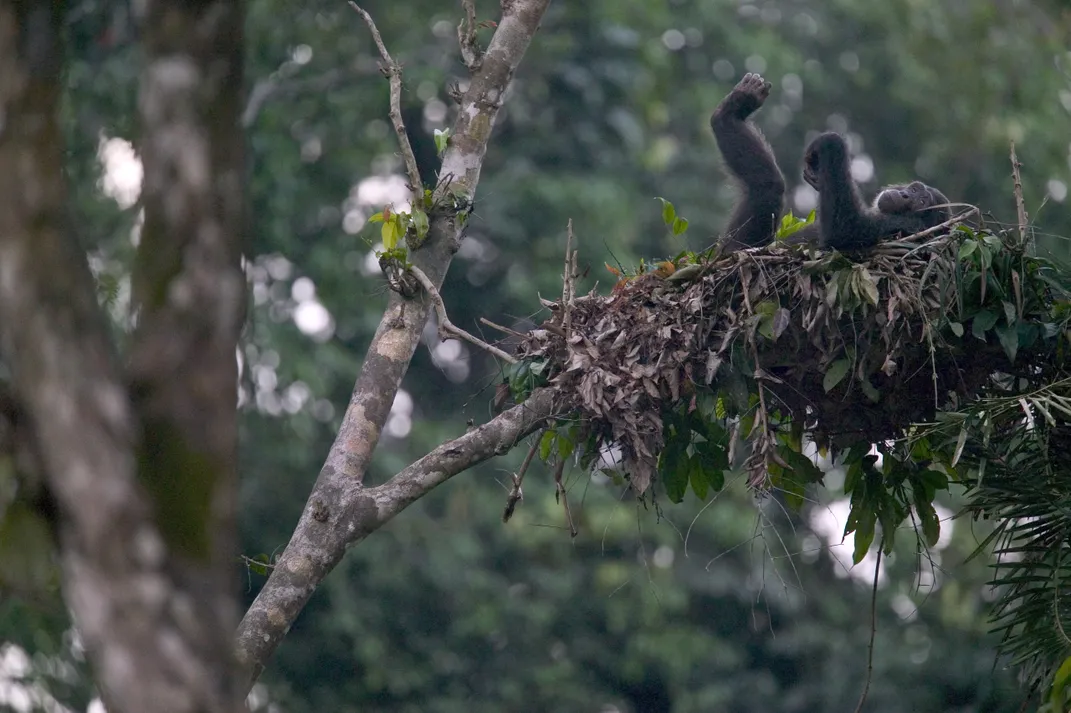Chimpanzees Are Extremely Picky About Where They Sleep
The primates painstakingly rebuild their nest from scratch every night—a pre-bed ritual reminiscent of the “Princess and the Pea”
/https://tf-cmsv2-smithsonianmag-media.s3.amazonaws.com/filer/01/93/01937c60-646e-47fe-85c2-52525065b2cf/chimp3.jpg)
Most humans have a pre-bed ritual. This might include things like showing, brushing teeth, flossing, getting a glass of water and setting an alarm. But regardless of the particulars prior to turning off the lights, night after night, those activities usually lead us to the exact same place: the comfort and familiarity of our bed.
Chimpanzees, on the other hand, completely upturn a human’s ideal of preparing for a good night’s sleep. Like a ritualistic Ragnarok of slumber, each night chimps recreate their place of rest, constructing a brand new sleeping nest from scratch. This time-consuming task involves bending and breaking stiff stems and interweaving it with foliage to create a thick, bouncy mattress-like structure.
Finding a branch to build a nest and gathering fresh twigs and leaves—the animal equivalent to bed frames, blankets and pillows—each and every evening seems like tedious, tiresome tasks, but chimps go about it with a nitpicky reverence for detail. As new research published in PLoS One reveals, any old tree in the forest will not satisfy a discerning chimp looking to construct his or her one-use-only nest. Rather, selecting a suitable place to sleep involves finding the perfect branch on the perfect tree—the princess, ensuring that her bed is free of any potential peas.

Researchers have long suspected that chimps are pretty picky sleepers, but no one has quantified just what standards those animals look for in choosing a nightly nesting site. The authors of the new study sampled 1,844 nests at Toro-Semliki Wildlife Reserve in southwest Uganda. They recorded the type of tree each of those nests occurred in, along with the physical characteristics of the trees, including branch stiffness and bending strength and leaf shape and density. All together, they gathered data from seven different tree species that the chimps used.
One tree species in particular dominated the nesting sites. Cynometra alexandri—colloquially known as Ugandan Ironwood—cradled more than 70 percent of the chimps’ nests. But that species represents less than 10 percent of the trees in the habitats the researchers sampled in. On the other hand, the most common tree, Beilschmiedia ugandensis, comprised more than 40 percent of the trees in the forest but accounted for just 16 of the nests the researchers sampled—less than one percent. Clearly, the chimps saw something special in those relatively rare but highly preferred Ugandan Ironwoods.
The team statistically analyzed the data collected from the various nest sites and found that Ugandan Ironwoods provided the stiffest and most stress resilient branches—of all the nest harboring trees, the branches of the ironwood were most difficult to break. That species also had the smallest distance between its leaves, and its branches tend to form an upside-down tripod shape. The chimps likely take advantage of all of those extra leaves for padding, the researchers think, and the branch shape would cradle them and prevent them from rolling out of bed. Additionally, the researchers suspect that dense foliage might shield them from the prying eyes of predators, insulate them on cold nights, and even deter some biting insects.
For now, the researchers have only investigated the chimps’ bed frames of choice. Future studies, they write, will focus on the grassy materials and weaving patterns that the primates use to create the ideal bedding for their lofty nests.
/https://tf-cmsv2-smithsonianmag-media.s3.amazonaws.com/accounts/headshot/Rachel-Nuwer-240.jpg)
/https://tf-cmsv2-smithsonianmag-media.s3.amazonaws.com/accounts/headshot/Rachel-Nuwer-240.jpg)